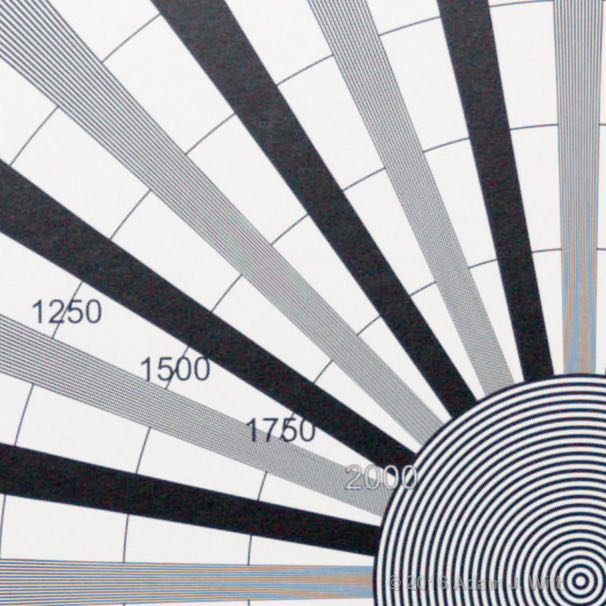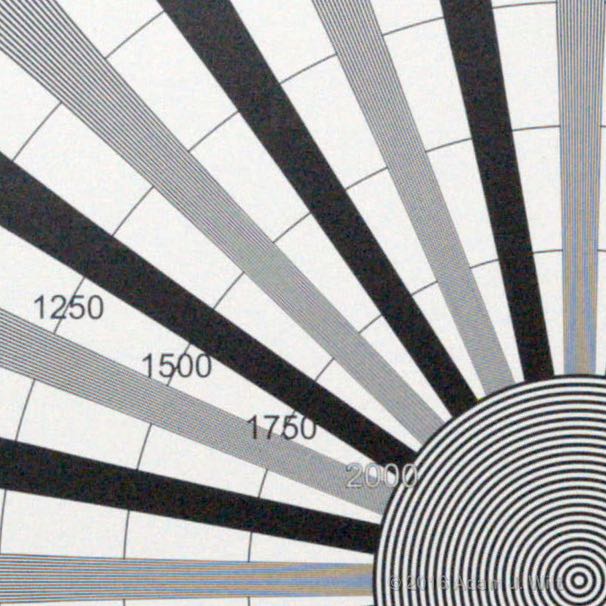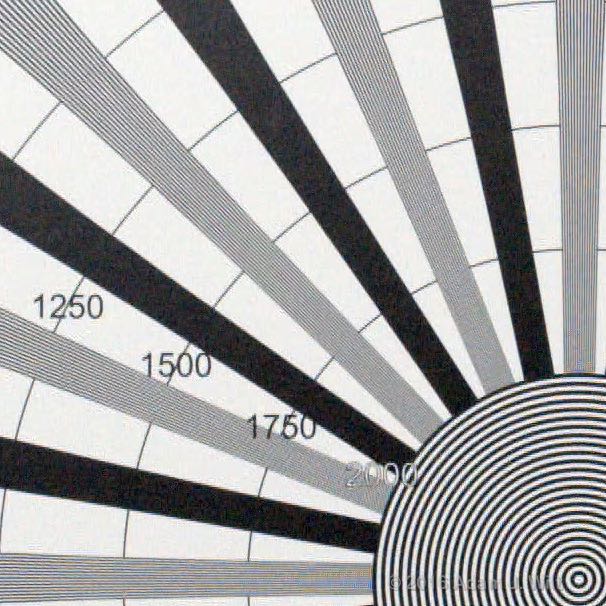[This is the continuation of my VariCam LT review. If you haven’t read Part 1 yet, here it is.]
Performance
Resolution and Aliasing
A confession: I shot most of my tests at ISO 5000, just because I could. But that makes sample stills look noisier than normal, so I re-shot one resolution test at ISO 800, so you can compare them.
All images were shot in V-Log, bypassing the camera’s sharpening. Resolve was used to decode the raw DNG files, and aside from setting the raw decoder to use camera metadata for color space and gamma, no changes were made to the default settings. When a codec could be used in both 4K and UHD, or in 2K and HD, I saw no difference in resolution or quality between the “cinematic” width and the “television” width. Unlike certain other Panasonics, the LT doesn’t use a bewildering variety of rescalings and resamplings; 4K and UHD are pixel-for-pixel captures from the sensor; 2K / HD full-frame are 2x downsamples, and 2K / HD crop-mode images are again pixel-for-pixel captures.
2160p (4K and UHD)



There are four variants of 4K/UHD capture: normal AVC-Intra 422 recording, high-speed AVC-Intra LT recording, AVC Long-GOP recording (added after my testing), and raw recording using an Odyssey 7Q+. The AVC-Intra files I recorded played back in both FCPX or Resolve 12.5 with essentially identical results; the raw files were processed in Resolve.
The rule of thumb is that a Bayer-pattern sensor can yield clean pix to perhaps 80% of the pixel-count value, or around 1728 TVl/ph for a 2160p image. The AVC-Intra 422 files resolve around that much, with diminishing detail thereafter subject to aliasing. There’s also a fair amount of chroma aliasing, perhaps twice as much as I’m used to seeing on comparable clips from other 2160p single-sensor cameras.
AVC-Intra LT is vertically coarser, almost stair-stepped on diagonals. High-speed codecs and high-speed recording often sacrifice image-rendering finesse in their rush to capture a firehose feed of data, and that seems to be case here.
Interestingly, LT clips show less chroma aliasing.
Raw clips are much crisper, showing detail (aliased or otherwise) right out to the 2000 TVl/ph limit of the chart, with very low chroma aliasing.
Why is AVC-Intra 422 softer? It’s likely that Panasonic is pre-filtering the data upstream of the codec to suppress compression artifacts generated by overly-sharp edges. Certainly the AVC-Intra footage is very clean; it took heroic measures enlarging AVC-I images and boosting contrast on them before I saw any noticeable blocking, edge noise, or other compression artifacts on them (AVC-Intra LT, with its reduced bit budget, does show a fair bit of mosquito noise ‘round sharp edges).
The strong chroma aliasing on the AVC-Intra clips is somewhat distressing, too. However, test charts are the worst possible thing to shoot (that’s why they’re test charts, after all)—real-world footage is much less likely to show such vigorous false color, and indeed I didn’t see anything so dramatic in my real-world shots.
In the real world, here’s a pixel-for-pixel, side-by-side comparison of an AVC-Intra clip and its raw equivalent. This is the most dramatic example I could find; neither the softness nor the chroma aliasing are noticeable in most real-world images and it requires a side-by-side test to see them:
The raw footage is crisper, if not substantially so. If you look closely, some of the single-pixel-wide branches on the AVC-Intra side show some green/magenta aliasing depending on which row or scanline of the image they fall on. So yes, there’s a pixel-peeping difference, but it’s not a significant one, practically speaking.
(I tried to superimpose one image on top of the other to difference them and encountered an interesting alignment issue. It seem that the pictures decoded from the DNGs are offset half a pixel both vertically and horizontally compared to internal recordings. Keep this in mind if you send out internal clips as VFX proxies and then intend to marry the VFX footage precisely with raw footage.)
There was no difference in performance between 4K (4096-wide) and UHD (3840-wide) clips. I also saw no difference between 10-bit and 12-bit raw recordings as far as resolution was concerned. Raw output quality was also the same regardless of whether the internal codec was set to AVC-Intra 422 or AVC-Intra LT.
1080p, 2K or HD, full-frame
As you might expect, full-frame downscaled to 2K or HD resolves out to about 1080 TVl/ph and shows minor aliasing beyond that. 2K/HD full-frame is recordable at all supported frame rates without resorting to the LT codec variant: the limit is in getting 8 Megapixels of 4K data off the sensor, not in recording the 2K version of it to P2.
1080P, 2K or HD, crop mode
As crop mode is 1080-line native, we’d expect good data out to around 860 TVl/ph and complete detail extinction at 1080 TVl/ph, and that’s pretty much what we see. Again, the LT codec has a coarser rendering and more compression artifacts.
Rolling Shutter
I measured rolling shutter at around 1/61 to 1/69 second in all full-frame modes, be they 4K, UHD, 2K, or HD recording.
In crop mode, when using the AVC-Intra 422 codec, rolling shutter is around 1/128 to 1/134 sec. This is pretty much what one would expect; the time it takes to read out the sensor is normally proportional to the number of columns being read.
But when I shot crop-mode AVC-Intra LT, rolling shutter dropped by another factor of two, to 1/254 – 1/270 sec. Clearly, Panasonic is doing something unusual to read out the sensor in crop-mode LT so as to get that additional speed.
Sensitivity and Noise
The VariCam’s sensor has a dual-ISO design, nicely described in this Panasonic PDF. It’s claimed that “the noise performance of the camera at ISO5000 is very similar to that of ISO800. (Measured SN/R differences are only about 1dB).”
For best results, view these 1920×1080 images full-size.
Here’s a chart shot at native (or base) ISO 800:
Here’s the same chart captured at base ISO 5000:
To my eyes, ISO 5000 is noticeably noisier than ISO 800 (you’ll only see this if you view the images at full resolution; downscaling ’em hides any noise quite convincingly). Perhaps a more interesting test is to shoot the chart at the same ISO, but using the two different base settings and varying electronic gain on top of that:
ISO 4000 from a base of ISO 5000 is definitely a stop or two cleaner than ISO 4000 from a base of ISO 800.
Want some real fun? The maximum sensitivity is ISO 12800:
(The chart wasn’t flagged off properly for this shot, so you’ll see some reflections on the chart. Just look at the noise levels, and color quality.)
Generally speaking, I see slightly more noise at the “base ISO” of 800 with the VariCam than I’m used to from comparable Sony or Canon cameras. This is not unexpected; Panasonics are often a tad noisier than the competition. But the ISO 5000 base readout offers a nice reduction in noise at higher gains, and even ramping the sensitivity up to unreasonable levels yields an image with excellent color, detail, and tonal-scale rendering, virtually identical to those found at more sensible ISOs.
Many lesser cameras offer similar high-gain sensitivities, but few keep a consistent color and tonal rendering when they do so. This consistency makes the VariCam LT much more usable at high gains than you might otherwise expect.
Dynamic Range
The short answer: yup, 14+ stops in V-Log. V-709 keeps that entire range in a more viewer-friendly contrast; the V-Look and BC Look gammas hold onto at least 13 stops, even without pushing stuff ‘round in post (not that you’ll be able to pull detail out of their highlights and shadows nearly as easily as if you captured in log, of course).
For comparison purposes, I shot the DSC Labs Xyla 21 chart, a transmissive target where each bar is half the brightness of its leftmost neighbor, and exposed so the first bar just hit clipping: the bars are one stop apart in brightness. I normalized each clip in post so that the black level was at around 7% and peak white was at 100%. Then, just for fun, I took a GH4 in V-Log L and clipped three bars (since V-Log L is supposed to have 12 stops of range to V-Log’s 14, losing the top two stops), and scaled it to match the LT in V-Log.
Color and Tone
The VariCam, as previously mentioned, uses an improved color filter array that purports to offer color discrimination comparable to the filters used in 3-chip cameras, thus yielding more natural, better separated colors with more subtle color differences discernible. And Panasonics, in general, render naturalistic, neutral colors.
Here’s what I got shooting a Cine ChromaDuMonde chart, lit with tungsten, for each of the camera’s default built-in looks (V-Log processed using the V-709 LUT looks just like V-709, not surprisingly):
Any of these could be pulled into perfect alignment on the vectorscope with a few minutes of work with the matrix and color correction settings:
Here’s a real-world capture:
What’s the big deal, you say? When I saw this played back, I thought, “that’s exactly what those leaves look like. It’s not a good picture of the leaves, it’s what the leaves look like.” Just for grins, I went out and shot the same leaves the next day with my GH4. I got a very nice picture of the leaves for my trouble, but it’s not as subtle and accurate an image as the VariCam made.
I’ve only had that happen once before. I was shooting some tests with Art Adams at Chater Camera. We had an Arri Alexa shooting a ChromaDuMonde chart and displaying its output on a brand-new Sony OLED monitor. The chart on the monitor looked exactly like the chart on the stand: not a good picture of the chart, but what the chart looked like.
The VariCam, like the Alexa, reproduces what it sees in a neutral, naturalistic, and accurate way, without surprises. (I’m not claiming that Panasonic’s color is the same as Arri’s color, just that they seem darned similar in their rendering. I haven’t put the two cameras side-by-side to compare ‘em so I can’t properly say quite how similar they are.)
But don’t take my word for it. Sit down with a nicely calibrated monitor and use your favorite search engine to find VariCam LT videos online. See what you think.
I should point out that I’m not throwing shade on Canon or Sony colorimetry here. Different cameras offer different “palettes”; if you prefer the way Panasonic renders images, you’ll like the LT rather a lot. If your preference is for Canon or Sony color, the LT may leave you cold. Choices are good, eh?
Highlight handling—specifically, the appearance of hue shifts or other color errors as the brightness level heads towards clipping— is superb in V-709 and very nice indeed in V-Looks, which gradually taper or S-curve highlights. The broadcast looks use traditional knees, and show a more typical, video-like shift towards secondary colors as levels head towards clipping, before blowing out to white.
In the following pix (which, depending on your preferences, are either highlight-color-shift test images, or contenders in a gratuitously-ugly-scene contest), the white balance is set to 3200 K, while the Diva-Lite is using 5500 K tubes, so all the light in the scene is blueish. These are crops from the EVF feed recorded externally, then graded so that the peak brightness in each shot is below 100%, so there won’t any added clipping in the JPEG output and onscreen display. See what happens to color in the hotspot as the pool of light on the wall changes…
Conclusion
The VariCam LT offers a subtle, sophisticated color palette, 14+ stops of dynamic range, and excellent low-light capability in a variable-frame-rate 4K camera at a midrange price. It comes standard with a positive locking EF mount with full electronic control and has an optional, user-changeable PL mount with both LDS and /i data pins. It has a cine-style control panel on a 3-foot cable, so you can configure and operate the camera from either side or even a short distance away. It captures 10-bit AVC-Intra internally and outputs raw 10- or 12-bit 4K/UHD frames at up to 60fps for external recording. 12-bit, 4:4:4 codecs are available for internal HD recordings, too. It can be had with an excellent zoomable EVF, and a shoulder mount with articulated handgrip—or use any other shoulder mount and/or SDI-capable EVF of your choice.
It’s not perfect: live audio control is limited, and the 20-second reboot cycle gets tiresome.
Internal recordings show somewhat higher color aliasing on fine details, and slightly softer images, than a comparable Sony or Canon (probably as a result of prefiltering to reduce compression artifacts), though both characteristics can be avoided by recording raw externally.
Is there a place for the LT in the crowded market for Super35mm cine-style cameras? I’d suggest that if you like the way an Alexa renders a scene, but need 4K and/or can’t handle the cost of an Alexa, the LT is definitely worth a look.
Pros
- Super35mm 4K/UHD sensor with 14+ stops dynamic range.
- Naturalistic, predictable color with excellent hue discrimination.
- VFR: 1–60fps with full-frame images, 1–240fps in crop mode.
- One-shot and interval recording; pre-record.
- Positive-locking EF mount with PL mount option.
- Great low-light performance.
- 10-bit 4:2:2 internal recording with 12-bit 4:4:4 options in HD.
- 10- and 12-bit raw output.
- Onboard cine-style LUTs and editable CDLs—no LUT box needed for on-set grading.
- V-709 and V-Look cine-like looks, plus broadcast looks.
- Video-style scene files with full matrix and 24-pole color correction.
- Six-button cine-style control panel.
- Multiple exposure and focusing aids.
- EVF lookaround.
- Anamorphic desqueeze.
- Very flexible and usable handheld rig.
- Crisp, compact EVF with nearly 2x optical zoom.
- EVF feed is SDI, so you can use any third-party EVF.
Cons
- On-board sensor deBayering shows chroma aliasing on fine detail.
- Internal recordings are slightly soft.
- Poor realtime audio level control.
Cautions
- Rebooting takes about 20 seconds.
- There aren’t many accessory mounting points on the body.
- No 4K monitoring output (aside from the raw feed).
Recommended Accessory
- Raw recorder: Convergent Design Odyssey7Q or 7Q+ monitor/recorder with raw option (if you prefer Atomos, raw support in the Shogun Inferno was scheduled for December 2016, and it may indeed be shipping by now, though the Atomos website is ambiguous on the matter).
Bottom Line
Color and tone reminiscent of an Arri Alexa, for around half the purchase or rental price. Plus, it’ll shoot 4K.
Disclosure: Panasonic sent me a complete VariCam LT package for review in October 2016, including an Anton-Bauer battery and charger and a Canon 24-70mm EF zoom. Unfortunately, they wanted it all back, so I had to return it (actually, I sent it on to the next reviewer). I have the Odyssey7Q+ on loan from Convergent Design, and I helped beta-test its VariCam raw recording update. I own the other lenses I used during testing. I purchased some of the DSC Labs charts; others were sent to me for testing and review; the Xyla is on loan from DSC. Nobody influenced me to write a favorable review nor was any compensation or other consideration provided. I am a beta-tester for Convergent Design and a sometime consultant to DSC Labs; beyond that there is no material connection between me and any of the manufacturers mentioned.
An earlier version of this review was posted on DVInfo.net in November 2016. This version has been re-edited, and updated to discuss the most recent firmware version.

